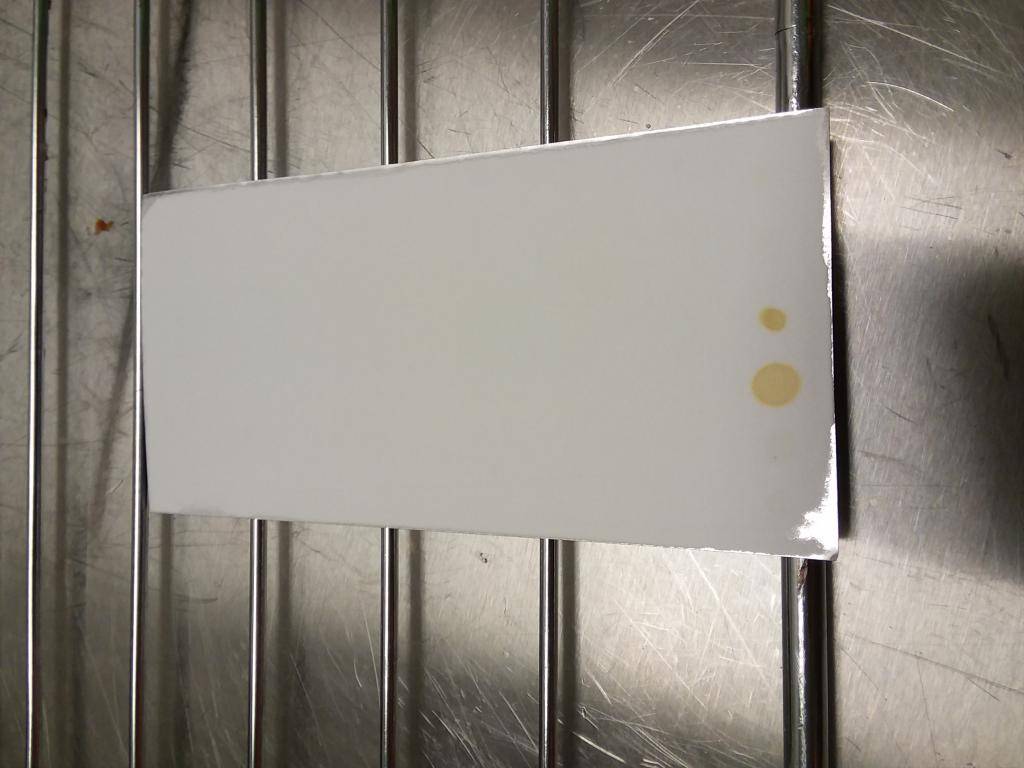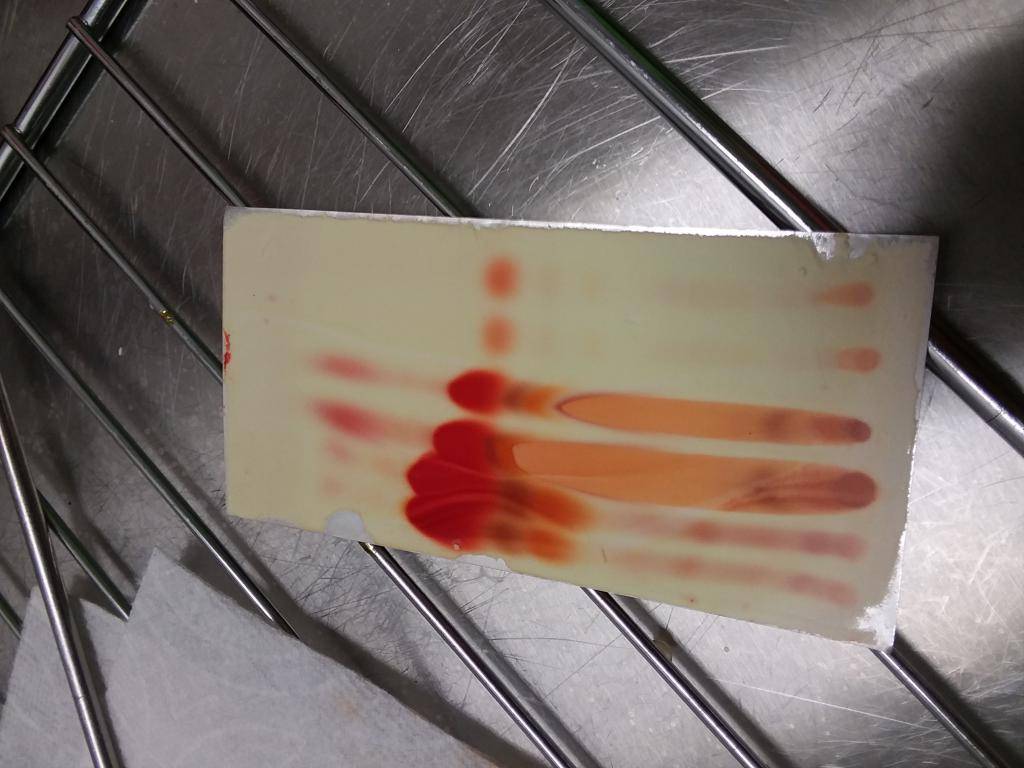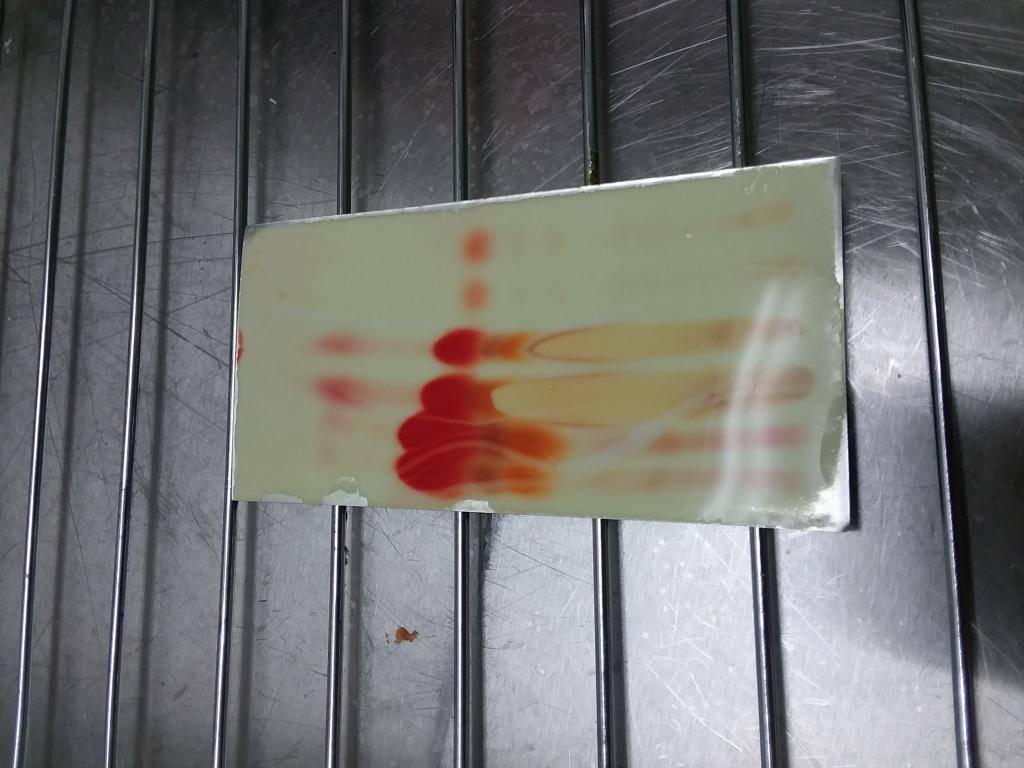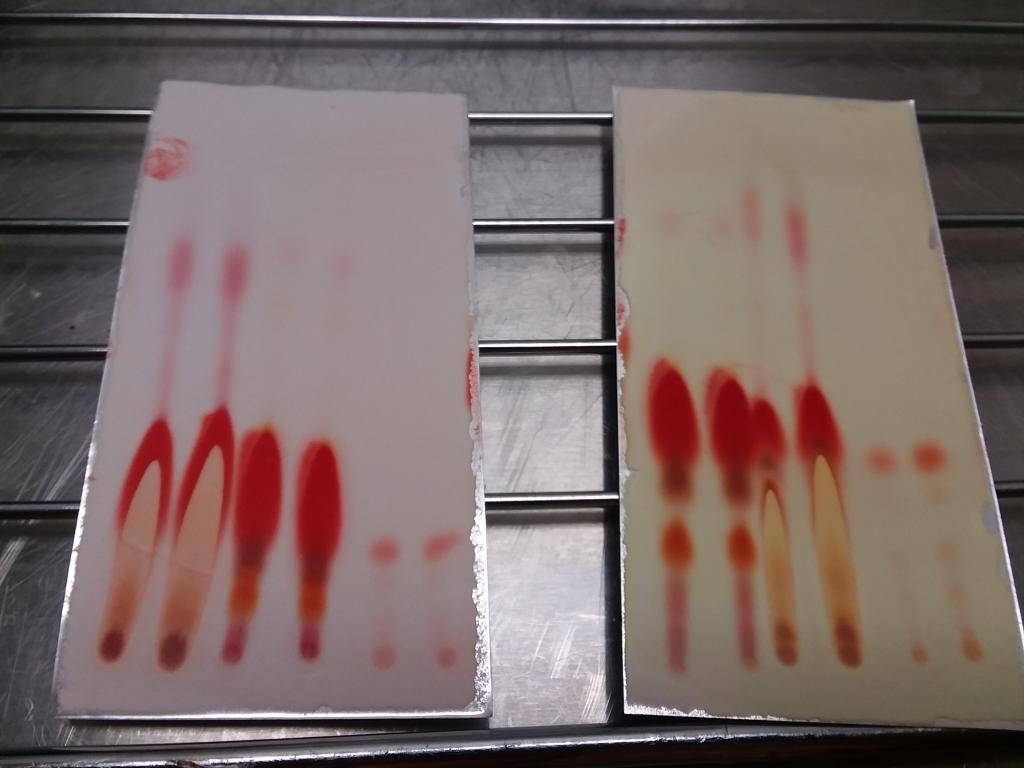no ive never heated my plates, havent felt the need to, i keep them stored in an airtight bag with a lot of silica and rice tho
Home TLC Thin layer chromatography
- Thread starter Thread starter NotGuilty
- Start date Start date
Comparison testing of dried plates is a good idea. Here it is put your check in the mail FBBB base this time example 2 of US patent 2,628,959 claims FBBB made by mixing 43 ml of 33-34% HCl, 342 ml water, 30 grams FBBB base and cooling to 5°. To this is added 7 g. sodium nitrite as a 30% solution. An excess nitrite test is maintained for 30 minutes with starch-iodide paper. The diazo solution is clarified by treatment with diatomaceous earth. 10 g. of the surface active agent N,N-diethyl-N'-stearoylethylenediamine acetate are mixed with the clarified solution, followed by addition of 7 g. zinc chloride dissolved in 21 cc. water. The resulting crystals are filtered and then dry mixed and standardized with sodium sulfate, calcined magnesium sulfate, and anhydrous aluminum sulfate.
The crystals are larger than those formed by treatment with zinc chloride in the absence of the surface active agent and have a lower water content, thus necessitating the use of less of the calcined magnesium sulfate and anhydrous aluminum sulfate. The storage stability is likewise better.
Similar results are obtained if the surface active agent N,N-diethyl-N'-oleoylethylenediamine acetate is used in place of the surface active agent of this example.
There are probably many ways to omit their surface active agents. Vacuum filtration and desiccators without heating come to mind. If your FBBB salt is 80% dye content maybe this explains much of the other 20%. The patent also says
In order to inhibit decomposition of stabilized diazonium salts during storage, it is necessary that they be kept as dry as possible. This is accomplished generally by admixing with the stabilized diazonium salts anhydrous agents such as anhydrous sodium sulfate, anhydrous magnesium sulfate and partially dehydrated aluminum sulfate. These compounds combine with water to form water of crystallization and thus keep the diazonium salts dry. The less water initially present in the filter cake, the smaller the amount of such dehydrating agent which must be used. In view of the larger crystal structure or changed crystal aggregate formation resulting from the partial stabilization of the diazonium compound with the surface active agent, the filter cake contains only a fraction of the water which would be present in the same diazonium salt stabilized only by the usual complex salt formation obtainable from such compounds as zinc chloride, and hence requires smaller amounts of dehydrating agents. In the case of diazonium complex salts formed only from the conventional fast color salt stabilizers, such as the zinc chloride mentioned above, it is generally necessary not only to hydraulically press the filter cakes, but also to pre-dry them in ovens heated to approximately 40° C. for from 12 hours to 2 days in order to bring down the water content. Only after such rigorous drying treatment can they be dry mixed with the dehydrating agents. In view of the low water content of the filter cake obtained in the case of the diazonium complex salts partially stabilized with the surface active agent of this invention, this rigorous drying treatment is unnecessary. Hence, dry mixing of the dehydrating agents can be effected immediately after pressing the filter cake and the danger of partial decomposition of the diazo compound due to exposure to excessive heat for long periods of time is averted.
The crystals are larger than those formed by treatment with zinc chloride in the absence of the surface active agent and have a lower water content, thus necessitating the use of less of the calcined magnesium sulfate and anhydrous aluminum sulfate. The storage stability is likewise better.
Similar results are obtained if the surface active agent N,N-diethyl-N'-oleoylethylenediamine acetate is used in place of the surface active agent of this example.
There are probably many ways to omit their surface active agents. Vacuum filtration and desiccators without heating come to mind. If your FBBB salt is 80% dye content maybe this explains much of the other 20%. The patent also says
In order to inhibit decomposition of stabilized diazonium salts during storage, it is necessary that they be kept as dry as possible. This is accomplished generally by admixing with the stabilized diazonium salts anhydrous agents such as anhydrous sodium sulfate, anhydrous magnesium sulfate and partially dehydrated aluminum sulfate. These compounds combine with water to form water of crystallization and thus keep the diazonium salts dry. The less water initially present in the filter cake, the smaller the amount of such dehydrating agent which must be used. In view of the larger crystal structure or changed crystal aggregate formation resulting from the partial stabilization of the diazonium compound with the surface active agent, the filter cake contains only a fraction of the water which would be present in the same diazonium salt stabilized only by the usual complex salt formation obtainable from such compounds as zinc chloride, and hence requires smaller amounts of dehydrating agents. In the case of diazonium complex salts formed only from the conventional fast color salt stabilizers, such as the zinc chloride mentioned above, it is generally necessary not only to hydraulically press the filter cakes, but also to pre-dry them in ovens heated to approximately 40° C. for from 12 hours to 2 days in order to bring down the water content. Only after such rigorous drying treatment can they be dry mixed with the dehydrating agents. In view of the low water content of the filter cake obtained in the case of the diazonium complex salts partially stabilized with the surface active agent of this invention, this rigorous drying treatment is unnecessary. Hence, dry mixing of the dehydrating agents can be effected immediately after pressing the filter cake and the danger of partial decomposition of the diazo compound due to exposure to excessive heat for long periods of time is averted.
not sure exactly when my next TLC run will be, sometime in the next three months anyway, but i intend to sacrifice a plate to do some lanes with FRUIT mmm... just out of curiosity and cos i find it fascinating, and i know FBBB reacts to phenolics at least to some extent, not just cannabinoids (eg. Comparative analysis of strawberry total phenolics via Fast Blue BB). Maybe a lane for a grape, another for a strawberry, another for some wine and maybe some plum for the 4th... seasonal availability pending!
What's your plan/method of extraction?
Here's some tests using different solvent systems. No chloroform in this mix. Let's call this solvent system #3 for now.
This is the closest to chloroform I've gotten so far.
6 lanes is a bit too crowded for this 5x10
Demo'ing effect on spot size:

Heatgun dried plate:

Wet plate:

Here's some tests using different solvent systems. No chloroform in this mix. Let's call this solvent system #3 for now.
This is the closest to chloroform I've gotten so far.
6 lanes is a bit too crowded for this 5x10
Demo'ing effect on spot size:
Heatgun dried plate:
Wet plate:
gotta love the beautiful vibrancy of FBBB, made even more perdy with rich cannabinoid profiles  it definitely has brightness and contrast turned up a notch compared to the FBB it succeeded!
it definitely has brightness and contrast turned up a notch compared to the FBB it succeeded!
(disclaimer: i've never used FBB, but the literature states similar, and the pictures ive seen of FBB always seems to be darker/less bright tones compared to FBBB vibrancy ... FBB is still just as functional though I'm sure, just not as bright'n'pretty!)
nice experimental plates btw! doesn't take too many experiments for the suitable parameters (quantities etc) to reveal themselves to you about your setup, and all of a sudden ... TLC of cannabinoids becomes a simple process rock'n'roll!
rock'n'roll!
(disclaimer: i've never used FBB, but the literature states similar, and the pictures ive seen of FBB always seems to be darker/less bright tones compared to FBBB vibrancy ... FBB is still just as functional though I'm sure, just not as bright'n'pretty!)
nice experimental plates btw! doesn't take too many experiments for the suitable parameters (quantities etc) to reveal themselves to you about your setup, and all of a sudden ... TLC of cannabinoids becomes a simple process
One experiment I've neglected so far is developing plates without a wet paper backing the wa of the chamber.
I would assume I will get the same 25-30m for the solvent front to reach the top of the plate, like your results and AlphaCAT's. Curious how it will affect the Rf value, if at all.
I would assume I will get the same 25-30m for the solvent front to reach the top of the plate, like your results and AlphaCAT's. Curious how it will affect the Rf value, if at all.
YES!!! would be a very cool experiment, that's in regards to the Edge Effect™ which i only learned about a few days ago thanks to the book/pdf our savior GO Joe linked to -- ive never used filter paper around the edges before.One experiment I've neglected so far is developing plates without a wet paper backing the wa of the chamber.
Actually there's a now-laughable post of mine somewhere in this thread way back where i contemplated buying ball bearings, because i thought the non-flat base of my jar was causing the effect, so i wondered if flattening the bottom would fix the problem by raising the level around the edge of the jar (and i couldnt find any appropriate flat-bottom jars, so i thought maybe try ball bearings haha). If you look back at my previous chloroform plate scans youll see the edge effect in all its glorious strength. It doesn't really render the result much less reliable (can still see if there's no CBD or THC etc), its just not as clean to read, but its ok.
You seem to be getting relatively level results so the jar filter seems to be working, though i can still see some Edge Effect™
btw, going back to your quote from a few days ago...
do you appreciate the added level of color-coding (as opposed to Rf/location) now?!?I was told by someone on my IG account that the 254nm fluorescent plates can work to identify spots (by Rf value Im assuming), but obviously you won't have the advantage of "color coded" spots (which isnt all *that* useful IMO)
The color coding is absolutely useful IMO, helps differentiate streak vs separated cannabinoids. I remember reading about FBBBs advantages over FBB and Fast Corinth V a few years back, it's stuck in my head.
So far I am finding that concentration values arent absolutely important to Rf. For instance, I can't find much of an appreciable difference between say 10% and 20%. I find other variables to be far more important and impact the results much more.
Whats your plan for fruit extraction?
So far I am finding that concentration values arent absolutely important to Rf. For instance, I can't find much of an appreciable difference between say 10% and 20%. I find other variables to be far more important and impact the results much more.
Whats your plan for fruit extraction?
As far as color coding goes, my solvent system #3 seems to resolve some cannabinoids better than chloroform. In my previous picture post, you can see the brown spot right below the orange spot, right below the red THC. According to the AlphaCAT results, it represents CBC, CBG, and THC. The CBC wasnt so visible with chloroform...
I recall hearing this a few times on various YouTube lab tek videos, where they explain poor resolution can lead one to believe it is 1 spot on the plate when it is actually 2 close eluting compounds
I recall hearing this a few times on various YouTube lab tek videos, where they explain poor resolution can lead one to believe it is 1 spot on the plate when it is actually 2 close eluting compounds
Last edited:
what's solvent system #3?As far as color coding goes, my solvent system #3 seems to resolve some cannabinoids better than chloroform
btw apart from chloroform, the only other mobile eluent ive tried is Hexane : Diethyl Ether (4 : 1)
But chloroform seems to give better separation/resolution, it only requires one liquid measurement instead of two, and it doesn't assault the nostrils like Diethyl Ether does.
1) somehow put fruit aside and not eat, this is the hardest partWhats your plan for fruit extraction?
2) decarb one fucking grape lol
3) TLC with grapes, wine, strawberries
Im not expecting much/anything, but im just curious, and it's only one plate.
I might also be missing some other key part of the recipe, like using a recipe for FB visualization of phenolics rather than cannabinoids, but we'll see how it goes.
btw, another experiment i want to try soon is Hexane vs Chloroform for the extraction solvent. It would be great if chloroform is all that's needed for both extraction and mobile phase, and it seems that is the case as proven in previous posts in this thread by another member, but I would love to see how they compare ... does anyone have any idea what the difference might be?
what's solvent system #3?
Binary mixture of 2 common solvents, I can't say yet publically (send me a PM if interested)
Here's ss#5 on the right, next to #4 on the left. Looks like Rf around 0.4, better separation of THC away from THCA acids, but still not there yet.
Lanes are switched. Left plate (#4) is 2x crude, 2x distillate, 2x thca. Right plate (#5) is distillate, crude, thca. The left/1st version of each is usually one "big" application, with the 2nd being two or more smaller ones, typically about 1.5x volume as the first.
Looks like I'll need to do a ss#6 and maybr 7 to get an Rf of around 0.5 - 0.6, which I think might be ideal. If it works, I'll probably ditch the chloroform in favor of th new solvent system primarily for health safety concerns, but will have multple technical benefits in my work environment.
If you're ever interested in some more of what I'm up to, check out @thehealingarmchairchemist on Instagram.

Lanes are switched. Left plate (#4) is 2x crude, 2x distillate, 2x thca. Right plate (#5) is distillate, crude, thca. The left/1st version of each is usually one "big" application, with the 2nd being two or more smaller ones, typically about 1.5x volume as the first.
Looks like I'll need to do a ss#6 and maybr 7 to get an Rf of around 0.5 - 0.6, which I think might be ideal. If it works, I'll probably ditch the chloroform in favor of th new solvent system primarily for health safety concerns, but will have multple technical benefits in my work environment.
If you're ever interested in some more of what I'm up to, check out @thehealingarmchairchemist on Instagram.
why can't you say publicly? we're all trying to learn from each other, and you wouldn't even be at this point now if you hadn't received public help, in particular from people in this threadBinary mixture of 2 common solvents, I can't say yet publically (send me a PM if interested)
and even if you're contemplating making a commercial product (which i have no objections to if you're transparent instead of secretive about it) then your product MSDS (which will be legally required due to the chems used) will still probably have to state the % of your two binary components anyway! ... Alpha-CAT's (and others) MSDS was just as beneficial to me in figuring out the process as their tutorial was
So to me it seems a very futile exercise trying to come up with a "secret formula" for TLC cannabinoid analysis, but would get a lot of respect for coming up with a "unique but transparent/published formula", which would give customers extra confidence.




